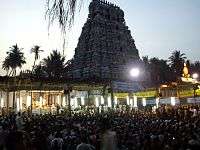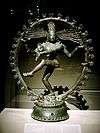Vaitheeswaran Koil
| Vaitheeswaran Temple | |
|---|---|
|
| |
 Vaitheeswaran Temple Location in Tamil Nadu | |
| Name | |
| Other names | Pullirukkuvelur [1] |
| Geography | |
| Coordinates | 11°11′42″N 79°42′51″E / 11.19500°N 79.71417°ECoordinates: 11°11′42″N 79°42′51″E / 11.19500°N 79.71417°E |
| Country |
|
| State | Tamil Nadu |
| Location | Vaitheeswaran Koil |
| Culture | |
| Primary deity | Vaidyanatha Swamy[2] |
| Consort | Thayyal Nayagi[2] |
| Temple tank | Siddha Amritam |
| Architecture | |
| Architectural styles | Tamil architecture |
Vaitheeswaran Koil [வைதீஸ்வரன் கோவில்] or Pullirukkuvelur[1] is a Hindu temple dedicated to the god Shiva located in Tamil Nadu, India. Shiva is worshipped as Vaitheeswaran or the "God of healing" and it is believed that prayers to Vaitheeswaran can cure diseases. Vaitheeswaran is a Tamil derivative from vaidya (Doctor) and Ishvara (God/Master). The presiding deity is Sri vaidyanAtha. He is the God of Healing. When pronouncing in Tamil, it sounds like "vaideeswaran". It is one of the nine Navagraha (nine planets) temples and is associated with the planet Mars (Angaraka).
The village is also known for palm leaf astrology called Naadi astrology in Tamil. It is located 7 kilometers from Sirkazhi, 235 kilometers from Chennai, 27 km from Chidambaram, 110 km from Thanjavur and 16 km from Mayiladuthurai.
The holy waters of the Siddhamirtham tank within the temple complex contains nectar, and a holy dip is believed to cure all diseases.[1][2]
The temple is revered by the Tevaram hymns of 7th-century Saiva nayanars - Tamil saint poets and is also classified as a Paadal Petra Sthalam (temple revered by the nayanars).
Legend
During the Ramayana period, Rama, Lakshmana and Saptarishi have worshipped the deity in this place.[3] There is a pond at this temple called Jatayu kundam (pot of Jatayu having holy ash of Vibhuti). One of the nine planets, Angaraka (Mars), suffered from leprosy and was cured by Vaidhyanathaswamy and from then on it is treated as one of the Navagraha Temples for planet Angaraka.[1] Parvati, the consort of Shiva, asked her son, Subramanya to appear with one face from his regular appearance of six faces. When he did so, she was pleased and presented him with vel (a weapon) to slay the demons.[4] Subramanya overcame the asura Surapadman (a demon) and in the war, his army was severely injured. Shiva came out as the healer Vaitheeswaran and cured the wounds.[4]
The Temple
The temple has a five-tiered gopuram (temple tower) and large precincts. The central shrine is that of Vaitheeswaran present as lingam in the inner most sanctum. The first precinct around the sanctum has the metal image of Subramanya, worhsipped here as Muthukumara Swamy. The other metal images in the sanctum are of Nataraja, Somaskanda, Angaraka and stone sculptures of Durga, Dakshinamoorthy, Surya (Sun god), Jatayu, Vedas, Sampati.[4] The shrine of Thaiyalnayaki who stands with the medicinal oil to cure the diseases of the devotees is present in the second precinct facing south. The large precinct also has a small shrine to Dhanvantari and shrine of Angaraka in stone sculpture. The southern gateway from this precinct leads to the temple tank and directly faces the Thaiyalnayaki shrine. The Sthala Vriksha (temple tree) is margosa (Azadirachta indica) which possesses medicinal properties.[4] It is located in the eastern gateway of the temple. The eastern gateway also has the shrine of Adi (original) temple that has a smaller replica of the main shrines. There is a fine metal image of Gangavisarjanar inside the temple.[4]
Inscriptions
The temple has five inscriptions mainly belonging to the period of Kulothunga Chola I (1070-1120 CE).[5] The inscription on the steps of Subramanya shrine records the shutter of the sluice at Sattainathapuram measures 35 inches in length and 8 inches in breadth.[4] The one on the right of the temple tank indicates the tank, Nachiyar shrine, and its hall were completely renovated when Kanderayar was governing the Sigali Simai, and during the management of the temple by Muthukumaraswami Tambiran, a disciple of Sivagnanadesikar-Sambandar of the Dharmapuram Adheenam.[4] On the wall of the second precinct, the inscriptions state that the courtyard of Thayalnayagi shrine, the sacred steps and Tattisuri hall were built during Tamil year 4868 corresponding to 1689 CE.[4] On the floor near accountant's seat registers a deed granted by Sankarabaragiri Rengopanditar by Ambalavanatambiran, an agent of the temple.[4] The Easter gateway inscription indicates the gift of taxes from Manipallam in Tiruvalipparu.[4]
Worship and festivals

Devotees take a holy dip in the temple tank before worshipping Vaitheeswaran in the temple. It is also a local belief that dissolving jaggery (Tamil:vellam) in the waters cures skin diseases.[6] Tonsure ceremony of getting children shaved for the first time to promote proper growth is a very common practise.[4] Mavilaku ma (litting lamp in rice cakes) is a form of worship practised. The practise of jamming salt and pepper in front of the temple mast and the pot near the temple tank is also followed. Unlike other temples in South India, where each shrine has a priest, each priest in the temple associates themselves with the devotees and perform worship on their behalf.[7] The holy soil rounded with ash (called Thiruchandu Urundai) is treated as medicine and believed to cure all the diseases.[8] Another medicine given is chandan (sandalwood powder) with saffron. It is a practice to purchase silver-plated images of body parts to put in the Hundi (vessel for offering) to fix ailments one might be having. The Veeraraghavaswamy temple at Thiruvallur is considered the Vaishnavite temple equivalent of healing abilities of the presiding deity to that of the Saivite Vaitheeswaran Kovil.[9]
Brahmotsavam (annual festival) is celebrated during the Tamil calendar months of Pankuni and Thai (January–February). Karthigai festival during November is also celebrated with pomp and glory. Kantha Sashti, a festive occasion for Subramanya, is celebrated in the shrine of Muthukumaraswamy.
The temple is a part of the popular Navagraha pilgrimage in Tamil Nadu. The planets are believed to influence the horoscope computed based on time of one's birth and subsequently influence the course of life. Each of the planets are believed to move from a star to another during a predefined period and thus sway over an individual's fortunes. The Navagrahas, as per Hindu customs, are believed to provide both good and bad effects for any individual and the bad effects are mitigated by prayers. As in other Navagraha temples, the common worship practises of the devotees include offering of cloth, grains, flowers and jewels specific to the planet deity. Lighting a set of lamps is also commonly followed in the temple.[10]
Nadi Astrology
Nadi astrology ('நாடி ஜோதிடம்' in Tamil), (nāḍi jyotiṣa) is a form of Hindu astrology practiced around the temple. It is based on the belief that the past, present and the future lives of all humans were foreseen by Hindu sages in ancient time.[11] The texts are mainly written in Vatteluttu, which is an ancient Tamil script. There are different schools of thought as to the author of these leaves. They are believed to be written by a Tamil sage called Agathiyar who is said to have had divine revelations. These Nadi leaves were initially stored in the premises of Tanjore Saraswati Mahal Library of Tamil Nadu. The British rulers later showed interest in the Nadi leaves concerned with herbs and medicine and future prediction, but ironically left most of the leaves to their loyal people. Some leaves got destroyed and the remaining were auctioned during the British rule. These leaves were obtained and possessed by the families of astrologers in Vaitheeswaran temple and was passed down the years from one generation to the other.
Literary Mention
The temple is revered by Tevaram hymns of saint poets Thirunavukkarasar and sambandar belonging to the 7th century. The poets name the towns where they found the temple in their hymns and Pullirukkuvelur finds a mention in their verses, corresponding to the temple.[12] The hymns appear to recognise the function of the mantras (sacred text) as invocation of Shiva. In addition the hymns from Thirunavukkarasar likens Shiva to luminous objects - a flame, a pearl, a diamond and pure gold.[13] He also indicates wasting lot of days not worshipping Shiva at this temple.[14]
- "வெள்ளெ ருக்கர வம்விர வுஞ்சடைப்
- புள்ளி ருக்குவே ளூரரன் பொற்கழல்
- உள்ளிருக்கு முணர்ச்சியில் லாதவர்
- நள்ளி ருப்பர் நரகக் குழியிலே."[15]
translating to
- Those who have no perception of the golden feet of deity in Puḷḷirukku Vēḷūr on whose matted hairs cobra and white yarcum flowers are mingled, staying in their minds. will be in the centre of the hollow of the hell.[16]
Temple administration
The temple is maintained by Dharmapuram Adheenam, a Saivite mutt or monastic institution located in the town of Mayiladuthurai, India. As of 1987, there were a total of 27 Shiva temples under the control of the adheenam.[17]
Transport
The temple is located between Sirkali to Mayiladuthurai State Highway. Frequent bus services are operated by Tamil Nadu government. There is a Railway station which is located between Chennai to Mayiladuthurai railway road. Karaikal is the nearest proposal airport located around 40 kilometer from temple.[18] Now Buses originate from Vaitheeswaran Koil to Chennai directly.
Notes
- 1 2 3 4 Tourist guide to Tamil Nadu 2007, p. 53.
- 1 2 3 Seth 2005, p.77
- ↑ Evensen 2007, p. 209
- 1 2 3 4 5 6 7 8 9 10 11 Ayyar 1991, pp. 260-261
- ↑ C.P.R. Environmental Education Centre 2002, p. 321
- ↑ Barnes 2005, pp. 65-66
- ↑ Raj 2006, p. 79
- ↑ Sundararajan 2003, p. 425
- ↑ Barnes, Linda L.; M., Talamantez, eds. (2006). Teaching Religion and Healing. Oxford University Press. p. 82. ISBN 9780190291983.
- ↑ Anantharaman, Ambjuam (2006). Temples of South India (second ed.). East West. pp. 43–47. ISBN 978-81-88661-42-8.
- ↑ Mersmann 2010, p. 209
- ↑ Prentiss 1999, p. 49
- ↑ Prentiss 1999, p. 58
- ↑ Prentiss 1999, p. 170
- ↑ Thirunavukkarasar, p. 39
- ↑ "Aintham Thirumurai". thevaaram.org. Retrieved 2012-08-06.
- ↑ Thangaraj 2003
- ↑ "Navagraha temples". Thanjavur District Administration. Retrieved 2013-07-07.
References
- Ayyar, P. V. Jagadisa (1991). South Indian shrines: illustrated. New Delhi: Asian Educational Services. ISBN 81-206-0151-3.
- Barnes, Linda L; American Academy of Religion; Ines M. Talamantez (2005). Teaching religion and healing. New York: Oxford University Press. ISBN 978-0-19-517643-8.
- C.P.R. Environmental Education Centre, . (2002). Sacred tanks of South India. C.P.R. Environmental Education Centre.
- Evensen, Anthony J; The University of Wisconsin - Madison (2007). Warrior-king, Siva-Bhakta, deity: Reconsidering Rama at Vijayanagara. MI: UMI. ISBN 9780549194491. Cite uses deprecated parameter
|coauthors=(help) - M., Thangaraj (2003). Tamil Nadu: an unfinished task. SAGE. p. 170. ISBN 0761997806, ISBN 978-0-7619-9780-1.
- Mersmann, Andrew (2010). Frommer's 500 Places Where You Can Make a Difference. United States: Wiley Publication. ISBN 978-0-470-16061-9.
- Prentiss, Karen Pechilis; Karen Pechilis (1999). The embodiment of bhakti. New York: Oxford University Press. ISBN 0-19-512813-3.
- Raj, Selva J.; William P. Harman (2006). Dealing With Deities: The Ritual Vow in South Asia. Albany: State University of New York Press. ISBN 0-7914-6707-4.
- Seth, Rabindra (2005). Tourism In India: An Overview (2 Vols.). Delhi: Kalpaz Publication. ISBN 81-7835-328-8.
- Sundararajan, K.R.; Bithika Mukerji (2003). Hindu spirituality: Postclassical and modern. USA: Cross Road Publishing Company. ISBN 81-208-1937-3.
- Thirunavukkarasar (2004). Aintham Thirumurai(http://projectmadurai.org/pm_etexts/pdf/pm0188.pdf). Online: project Madurai.
- Tourist guide to Tamil Nadu (2007). Tourist guide to Tamil Nadu. Chennai: T. Krishna Press. ISBN 81-7478-177-3.
External links
| Wikimedia Commons has media related to Vaitheeswaran Temple. |
| Wikivoyage has a travel guide for Vaitheeswaran Koil. |

